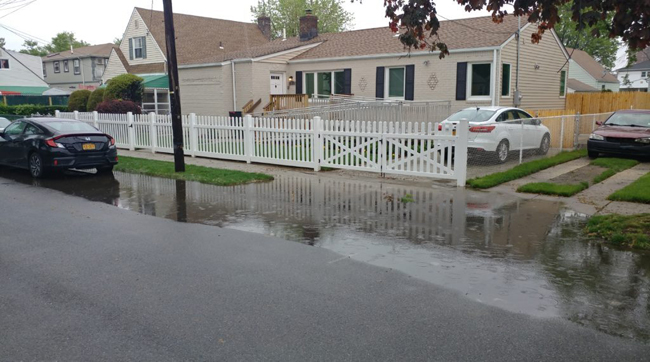
Flooding in Southeast Queens. Credit: The DDC
Experts, Voters Address Environmental Threats in City Council District 31 Ahead of Special Election
— By Jeff Winter and Keith Paul Medelis, Queens County Politics
Queens, NY, February 22, 2021 - Residents of District 31 in southern Queens know what it’s like to have flooded streets on a sunny day just because of high tide. They remember the havoc wreaked by Hurricane Sandy because they are still living with it. The candidates running to represent them in Tuesday’s special election, however, are quiet on environmental issues.
The district’s Feb. 23 race will fill the seat vacated by Queens Borough President Donovan Richards in December of last year. Of the nine declared candidates – LaToya Benjamin, Selvena Brooks-Powers, Latanya Collins, Sherwyn James, Nicole Lee, Nancy Martinez, Pesach Osina, Shawn Rux, and Manuel Silva – less than half mention climate-related issues on their campaign websites. Only Rux acknowledged flooding as a top priority issue during last week’s campaign events.
Most New Yorkers have moved on from Superstorm Sandy, but in District 31 (Arverne, Brookville, Edgemere, Far Rockaway, Laurelton, Rosedale, Springfield Gardens), which is still rebuilding nearly nine years later, old problems remain and new ones are knocking on the door.
Katie Graziano, coastal resilience specialist at nonprofit New York Sea Grant, said rising sea levels and high tide flooding – the regular flooding that comes with a new or full moon – are constant, serious threats.
“There are already streets in District 31 that get flooded regularly on sunny days, just from a higher-than-average high tide. When high tide coincides with storms, it’s even worse,” she wrote in an emailed statement.
Voter Jeffrey Williams-Maisonet, undecided but leaning toward Silva and Benjamin, said action needs to be taken fast.
“In the next three years, if improvements aren’t made, I don’t see how people are gonna be able to live here,” he said.
The New York City Panel on Climate Change estimates sea levels around the city will rise between 11 and 21 inches by the 2050s, between 18 and 39 inches by the 2080s and as high as six feet in 2100. Comptroller and Democratic mayoral candidate Scott Stringer issued a report in 2019 warning that “storms similar in impact to Sandy could become one-in-five year events as soon as 2030.”
Judah Asimov, senior manager of planning and outreach at the Rockaway-based Rise Center, said tidal flooding, erosion and poorly designed storm sewer systems have made for significant quality of life issues on the peninsula.
“The community has been talking about it for years,” he said. “Very little has done about it.”
Asimov advocates for better communication from his next city council member, especially when it comes to dealing with the rising sea level. He said massive infrastructure projects like sea walls were needed yesterday – not just for the next storm, but for the next high tide.
The city’s Build It Back program, launched to assist families displaced by Sandy, has had several well-documented failures, and residents have been pushing city officials for accountability on programs that were intended to benefit them.
“Sandy put Rockaway on the map,” said candidate Manuel Silva, Richards’ former chief of staff.
Silva said the money that came to the area after Sandy were welcome investments when the tragedy allowed the problems to become more widely known. Those dollars have remained largely dormant since. Stringer’s report found that as of March 2019 the City had spent just 54.1% of the $14.7 billion in federal recovery funding it received after Sandy.
“What we need to do is really to look at that money and ensure that it’s allocated for the needs of the residents and to ensure that they’re able to bounce back,” said candidate Pesach Osina when asked about his plans for the untapped fund.
Osina and Silva were the only candidates reachable before press time.
“What we need to do is we really need to hold the government accountable,” Osina said.
Ahmad “Ozzie” Edwards, who ranked Silva, Osina and Martinez on his ballot, has planned ahead: his home stands six feet above sea level. He said elected officials need to stop dragging their feet.
“We’ve been talking about this for how many years, and there’s still nothing done,” Edwards said.
For Edwards, holding those in power accountable for their actions, or lack thereof, is more pressing than climate change. He said he plans on being more engaged after the election, and hopes to get others involved as well.
“It’s time to make some noise,” he said.
More Info: New York Sea Grant
New York Sea Grant (NYSG), a cooperative program of Cornell University
and the State University of New York (SUNY), is one of 34 university-based
programs under the National Oceanic and Atmospheric Administration’s
National Sea Grant College Program.
Since 1971, NYSG has represented a statewide network of integrated
research, education and extension services promoting coastal community
economic vitality, environmental sustainability and citizen awareness
and understanding about the State’s marine and Great Lakes resources.
Through NYSG’s efforts, the combined talents of university scientists
and extension specialists help develop and transfer science-based
information to many coastal user groups—businesses and industries,
federal, state and local government decision-makers and agency managers,
educators, the media and the interested public.
The program maintains Great Lakes offices at Cornell University, University at Buffalo, SUNY Oswego and the Wayne County Cooperative Extension office
in Newark. In the State's marine waters, NYSG has offices at Stony Brook
University in Long Island, Brooklyn College and Cornell Cooperative
Extension in NYC and Elmsford and Kingston in the Hudson Valley.
For updates on Sea Grant activities: www.nyseagrant.org has RSS, Facebook, Twitter, Instagram, and YouTube links. NYSG offers a free e-list sign up via www.nyseagrant.org/nycoastlines for its flagship publication, NY Coastlines/Currents, which is published quarterly. Our program also produces an occasional e-newsletter, "NOAA Sea Grant's Social Media Review," via its blog, www.nyseagrant.org/blog.